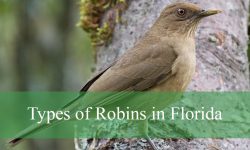Michigan’s forests, wetlands, and lakes provide the perfect environment for a wide variety of insects — some helpful, others hazardous. While most bugs are harmless or even beneficial, a few species across the state can bite, sting, or spread disease, making them a real concern for residents and outdoor enthusiasts.
From venomous spiders and aggressive hornets to blood-sucking ticks and flies, Michigan’s most dangerous bugs come in many forms. Each one poses a different kind of threat, whether it’s a painful sting, allergic reaction, or the transmission of serious illnesses like Lyme disease and West Nile virus.
Understanding how to identify these insects, where they live, and how to prevent encounters is the best defense against unpleasant surprises. This guide covers the 20 most dangerous bugs in Michigan, complete with descriptions, identification tips, and behavioral insights to help you stay safe while exploring the Great Lakes State.
Different Types of Dangerous Bugs Found in Michigan
Black-Legged Tick (Deer Tick)
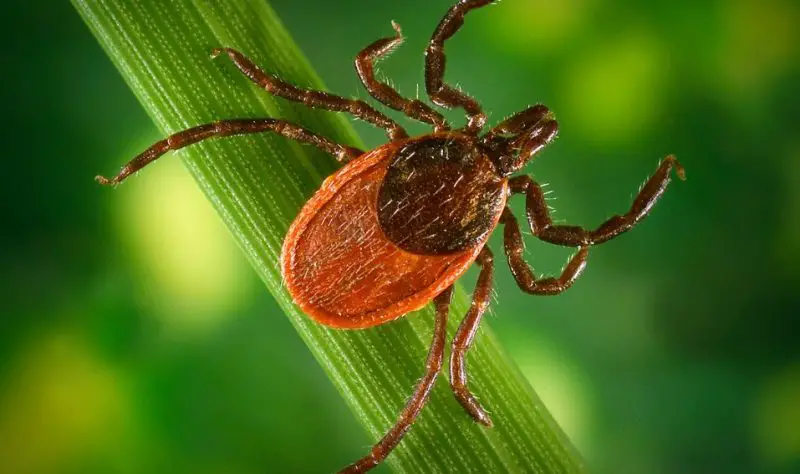
The Black-Legged Tick, also known as the Deer Tick (Ixodes scapularis), is one of the most notorious and dangerous bugs in Michigan. These tiny arachnids measure only about 3 mm when unfed but can swell up to 10 mm after feeding on blood. They are reddish-brown with darker legs and a distinctive flattened, oval body. Females are slightly larger than males and can be identified by their darker scutum (the shield-like plate near the head).
This tick’s most dangerous feature is its ability to transmit Lyme disease, as well as other tick-borne illnesses such as anaplasmosis and babesiosis. They become infected by feeding on animals like mice or deer that carry Borrelia burgdorferi, the bacterium responsible for Lyme disease. Once infected, they can pass the pathogen to humans through their bites, often going unnoticed for hours or even days.
Black-Legged Ticks are most active in late spring and early summer when nymphs emerge, as well as in the fall when adults are seeking hosts. They prefer humid, wooded environments with leaf litter, long grasses, and brushy areas. Michigan’s Lower Peninsula has seen a steady rise in their population, especially in the western and northern regions near forests and lakes.
When a tick bites, it inserts its barbed mouthparts into the skin and feeds slowly over several days. The bite itself is usually painless, but after the tick detaches, symptoms may include redness, swelling, or a circular rash known as the “bull’s-eye.” Untreated Lyme disease can lead to joint pain, neurological problems, and heart inflammation, making prevention and quick removal crucial.
Mosquitoes
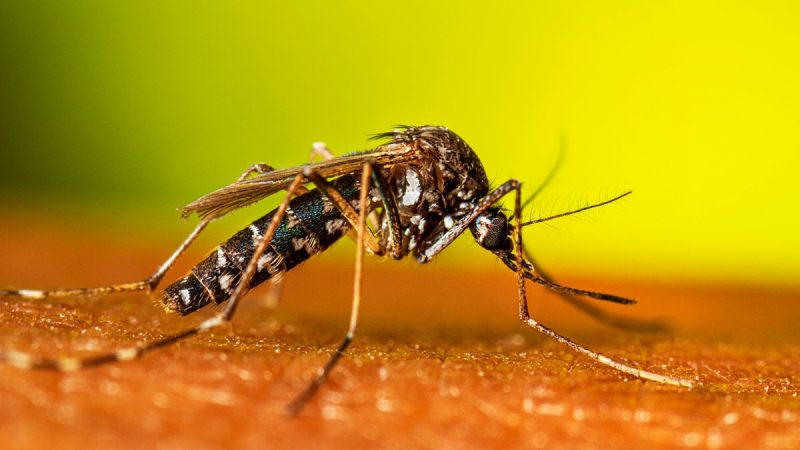
Mosquitoes are among the most widespread and dangerous insects in Michigan due to their role as disease vectors. Adult mosquitoes are small, slender insects, typically 3 to 6 mm long, with long legs, a thin body, and a pointed proboscis used for piercing skin and sucking blood. Females are the only ones that bite since they need blood to produce eggs, while males feed on nectar.
Michigan is home to over 60 species of mosquitoes, but the most concerning ones are those capable of transmitting West Nile Virus and Eastern Equine Encephalitis (EEE). Both diseases can cause high fever, brain inflammation, and even death in severe cases. The Culex species, responsible for West Nile Virus, are common in urban and suburban areas, while Aedes and Coquillettidia mosquitoes are often found in wetlands and rural zones, spreading EEE among humans and animals.
Mosquitoes thrive in standing water, which they need for laying eggs. Swamps, ponds, clogged gutters, and even birdbaths can serve as breeding grounds. They are most active during warm months, particularly at dusk and dawn. The humid summers of Michigan’s Great Lakes region create perfect conditions for their growth and survival, especially in counties along Lake Michigan and Lake Huron.
A mosquito bite begins as a small, itchy red bump caused by the body’s allergic reaction to mosquito saliva. For most people, the irritation is temporary, but in infected mosquitoes, the bite introduces viruses directly into the bloodstream. Preventing bites through repellents, mosquito nets, and eliminating standing water is the most effective defense.
Brown Recluse Spider
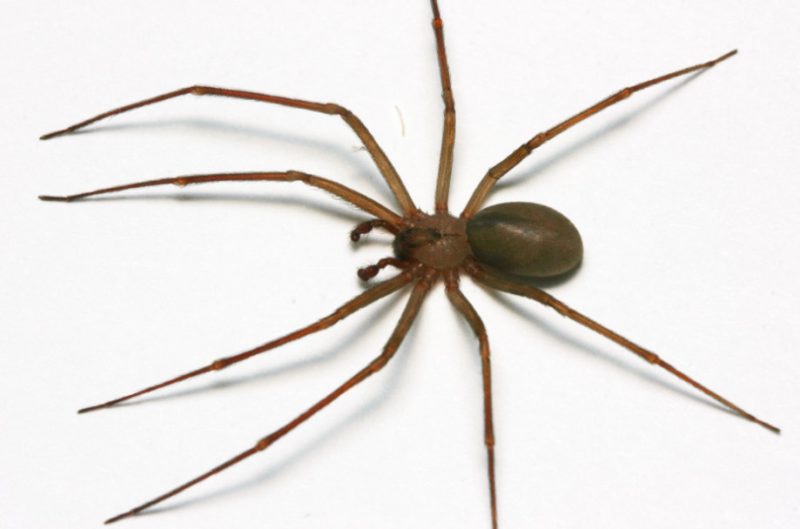
The Brown Recluse (Loxosceles reclusa) is one of the most feared spiders in the United States, and although it is rare in Michigan, occasional encounters have been reported, particularly in the southern part of the state. It is a medium-sized spider, about 6–20 mm in length, with a light to dark brown body and a characteristic violin-shaped marking on its back. Its legs are long, thin, and covered with fine hairs rather than spines, giving it a smooth appearance.
The Brown Recluse prefers quiet, undisturbed environments such as basements, closets, attics, and sheds. They often hide in shoes, clothing, or boxes left unused for long periods. These spiders are nocturnal hunters that feed on soft-bodied insects. They do not build webs to catch prey but instead use silk retreats where they hide during the day. While they generally avoid humans, bites can occur when the spider feels trapped or threatened.
The venom of the Brown Recluse is necrotic, containing enzymes that destroy cell membranes and tissue. A bite may not be immediately painful, but within hours, the area can develop redness, swelling, and eventually a blister that turns into an ulcer. In severe cases, the wound can expand into a deep lesion that takes weeks or months to heal. Systemic symptoms such as fever, chills, or nausea may accompany serious envenomations.
In Michigan, confirmed sightings are most common near Detroit and southern counties bordering Ohio and Indiana. However, most “brown recluse” reports turn out to be misidentified harmless spiders. Regardless, caution is advised when reaching into dark storage spaces, and any suspected bite should be examined by a medical professional promptly.
Black Widow Spider
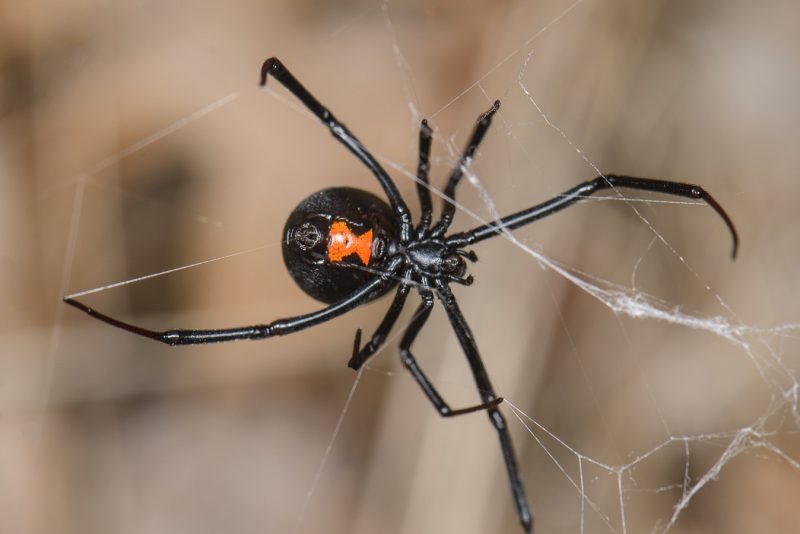
The Black Widow (Latrodectus mactans) is one of the few truly venomous spiders in Michigan. Recognizable by its glossy black body and red hourglass marking on the underside of its abdomen, the female black widow measures about 1.5 inches when fully extended, while males are smaller and lighter in color. Their appearance and venomous reputation have made them a subject of fear and fascination.
These spiders typically build irregular, tangled webs in dark, sheltered locations such as garages, woodpiles, sheds, or under rocks. They prefer warm, dry areas and are more common in southern Michigan, especially during late summer. Black widows are nocturnal and feed on insects trapped in their webs, using their strong silk to immobilize prey before injecting venom.
The venom of a black widow is neurotoxic, affecting the nervous system rather than tissue. A bite initially feels like a sharp pinprick, followed by intense pain that can spread to the chest, abdomen, and back. Symptoms may include muscle cramps, sweating, nausea, and difficulty breathing. While fatalities are rare due to modern antivenoms and medical care, bites can be life-threatening to children, the elderly, or those with compromised health.
In Michigan, black widow encounters are relatively rare but not impossible, particularly in rural and agricultural regions. They are shy and rarely bite unless provoked or accidentally pressed against the skin. People working outdoors or handling wood should wear gloves and inspect potential hiding spots carefully.
Bald-Faced Hornet
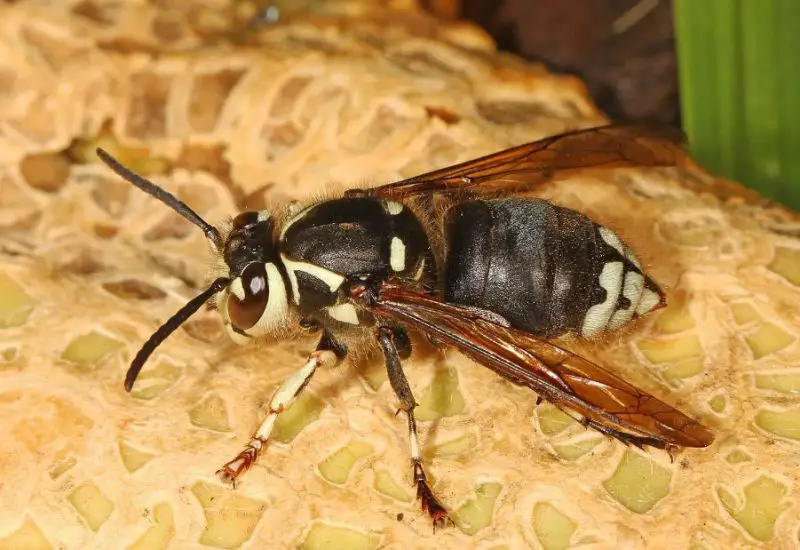
The Bald-Faced Hornet (Dolichovespula maculata) is one of Michigan’s most aggressive and recognizable stinging insects. Despite its name, it is actually a type of yellowjacket wasp rather than a true hornet. It has a large, robust black body with striking white markings on its face and abdomen, typically reaching about 0.75 inches in length. Its appearance and behavior make it easy to identify among other wasps.
Bald-Faced Hornets are social insects that build large, gray, paper-like nests often hanging from trees, shrubs, or building eaves. These nests can grow to the size of a basketball and house hundreds of individuals. The colony operates under a strict hierarchy, with a single queen, sterile female workers, and male drones. The hornets are extremely defensive of their nests and will sting repeatedly if threatened.
Their sting is painful and venomous, containing a mixture of toxins that cause intense burning, redness, and swelling. For most people, symptoms subside after a few hours, but in allergic individuals, even a single sting can trigger anaphylaxis — a potentially fatal reaction involving difficulty breathing and swelling of the throat. Unlike bees, hornets can sting multiple times without losing their stinger.
Bald-Faced Hornets are found throughout Michigan, from urban parks to rural forests. They are active from late spring until early fall, feeding on nectar, fruit juices, and other insects. Although they play an ecological role by controlling pest populations, their aggressive nature makes them a significant threat when nests are built near human activity. Professional removal is strongly recommended when one is discovered.
Paper Wasp
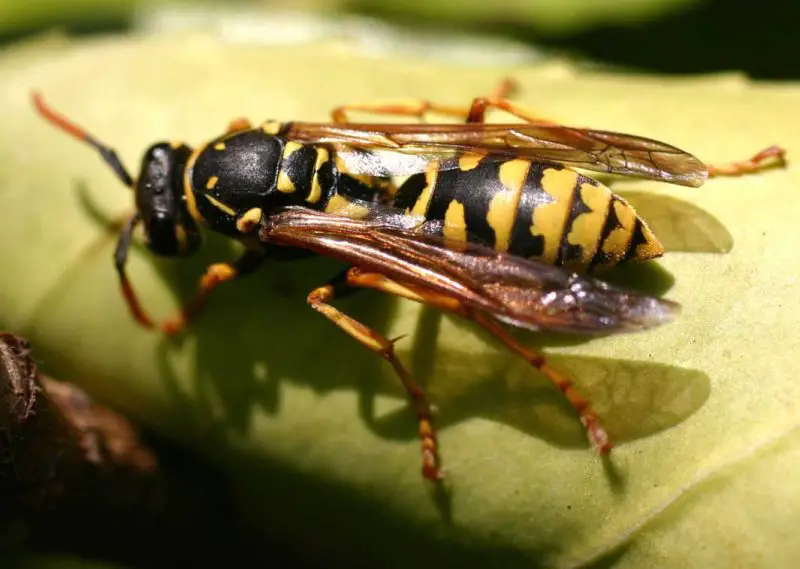
The Paper Wasp (Polistes dominula and related species) is one of the most familiar stinging insects in Michigan. Slender and elegant, these wasps typically measure about 0.75 to 1 inch long, with narrow waists and long dangling legs in flight. Their coloration varies from brownish-black with yellow or orange markings to more vibrant yellow and black patterns, depending on the species. Their delicate, umbrella-shaped nests made of chewed wood fibers are often seen under eaves, porches, or roof overhangs.
Paper Wasps are social insects that live in colonies led by a single queen, supported by sterile female workers. They are generally non-aggressive when left undisturbed but will defend their nests fiercely if threatened. Their behavior is more tolerant compared to hornets, but repeated disturbances can provoke coordinated attacks. These wasps are also beneficial predators, feeding on caterpillars and other soft-bodied insects that damage plants.
Their sting is painful and venomous, containing a potent mix of toxins that cause sharp, burning pain followed by redness and swelling. Unlike bees, Paper Wasps can sting multiple times and may release alarm pheromones that alert nearby wasps to attack. In allergic individuals, even one sting can lead to severe reactions such as hives, swelling of the throat, or anaphylactic shock.
Paper Wasps are widespread throughout Michigan and thrive in suburban gardens, meadows, and wooded areas. They are most active in summer when temperatures rise and food sources are abundant. While their ecological role is beneficial, their proximity to human dwellings makes them one of the most common stinging threats in the state. Proper pest control and nest removal during early formation stages can help prevent conflicts.
Yellowjacket
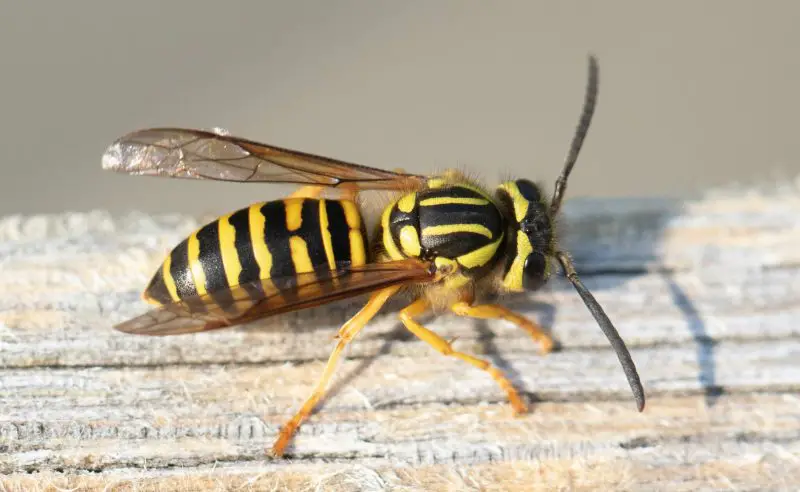
The Yellowjacket (Vespula vulgaris and related species) is among the most aggressive and dangerous wasps found in Michigan. These insects have compact, shiny black and yellow-striped bodies and are often mistaken for bees. However, they are smaller, more streamlined, and lack the fuzzy appearance of bees. Adult Yellowjackets measure between 0.5 and 0.75 inches long, with a fast, darting flight pattern that makes them easily recognizable in late summer and fall.
Yellowjackets are highly social, living in large colonies that can contain thousands of individuals. Their nests are usually hidden underground, inside wall cavities, or in hollow trees. They are defensive of their nests and quick to attack when disturbed, delivering multiple painful stings in rapid succession. During the late summer months, they become more aggressive as their natural food sources decline, leading them to scavenge around garbage cans, outdoor food, and picnics.
Their venom contains histamines, serotonin, and acetylcholine, producing intense burning and swelling at the sting site. For most people, pain and redness fade within a day, but those allergic to wasp venom may experience severe systemic reactions, including difficulty breathing, dizziness, or cardiac complications. Unlike honeybees, Yellowjackets can sting repeatedly without dying.
In Michigan, Yellowjackets are abundant throughout the state, from urban neighborhoods to forests. They are particularly active from July to October. Because their nests are often hidden, encounters are common when mowing lawns, gardening, or disturbing soil. Avoiding strong fragrances, wearing light-colored clothing, and sealing trash properly can help reduce Yellowjacket attraction.
Assassin Bug (Kissing Bug)
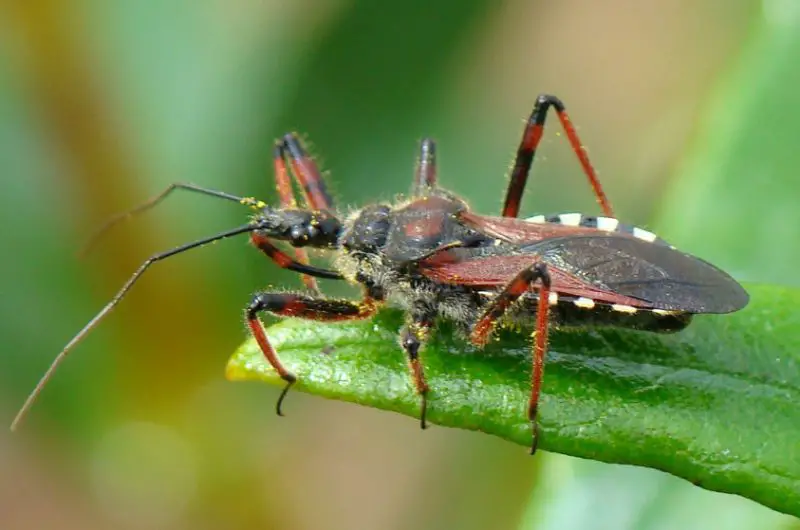
The Assassin Bug, also known as the Kissing Bug (Triatoma spp.), is an intriguing yet potentially dangerous insect. These bugs are about 1 inch long with elongated, dark brown or black bodies and orange or red markings along the edges of their abdomen. Their long, cone-shaped heads and piercing-sucking mouthparts make them easy to identify. Although the species that transmits Chagas disease is rare in Michigan, some close relatives occur in the state.
Assassin Bugs are ambush predators that feed on other insects by stabbing them with their sharp rostrum and injecting saliva that liquefies their prey’s internal tissues. They then suck out the fluids, leaving the prey lifeless. However, when these bugs come into contact with humans, they may bite defensively or accidentally while searching for a warm host. The bite is painful and swollen, sometimes leading to localized allergic reactions.
In parts of the southern U.S., related species of Kissing Bugs are vectors of Trypanosoma cruzi, the parasite that causes Chagas disease. While this disease is not endemic to Michigan, the bite itself can still cause discomfort, redness, and itching. Unlike mosquitoes, Assassin Bugs typically bite at night and are attracted to the carbon dioxide humans exhale.
In Michigan, Assassin Bugs can be found in grassy fields, gardens, and wooded habitats. They often hide under logs, stones, or leaf litter during the day. While not aggressive, it is best to avoid handling them. Their role as natural pest controllers makes them beneficial in small numbers, but caution is necessary if they enter homes or sleeping areas.
Giant Water Bug
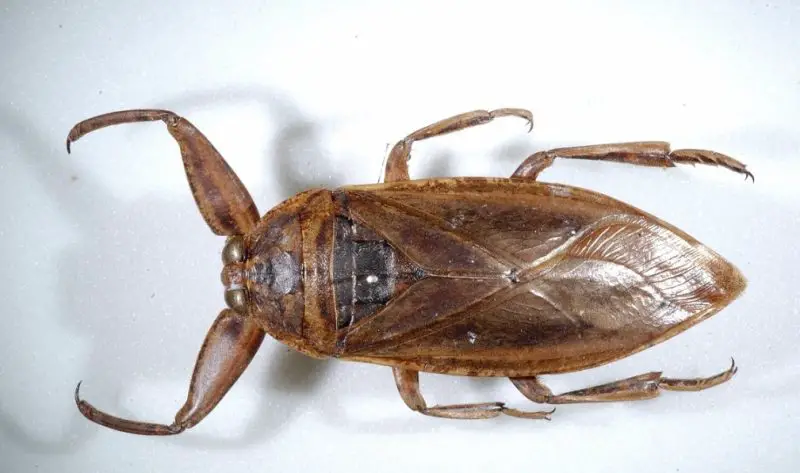
The Giant Water Bug (Lethocerus americanus) is one of Michigan’s largest and most intimidating aquatic insects, often called “toe-biters.” Reaching up to 2.5 inches in length, this insect has a flattened, oval-shaped brown body and large, raptorial front legs adapted for grasping prey. Their strong swimming hind legs are fringed with hairs, allowing them to move swiftly through ponds and lakes.
Giant Water Bugs are ambush predators that feed on fish, frogs, tadpoles, and even small snakes. They inject a digestive enzyme into their prey through their sharp beak-like mouthpart, paralyzing and liquefying tissues for consumption. While they are not venomous to humans, they can deliver one of the most painful non-venomous bites when handled carelessly or stepped on in shallow water. The pain is sharp and intense, often compared to a bee sting multiplied several times.
These insects are commonly found in freshwater habitats across Michigan, including marshes, ponds, and slow-moving streams. At night, adults are attracted to bright lights and may be found resting on walls or decks near water. They play a vital role in aquatic ecosystems as predators, helping to regulate populations of other insects and small aquatic animals.
Although the Giant Water Bug’s bite is not medically dangerous, it can cause local swelling and tenderness lasting for several hours. They pose little threat unless disturbed, but wading barefoot in shallow water increases the risk of accidental encounters. Wearing footwear and using caution around lights near lakeshores can prevent unwanted bites.
Blister Beetle
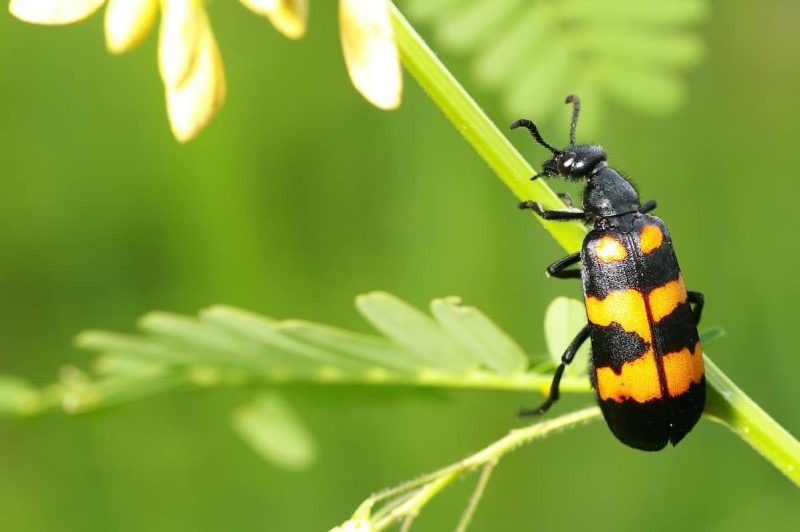
The Blister Beetle (Epicauta pennsylvanica and related species) is a slender, soft-bodied insect that poses a unique chemical threat rather than a venomous one. These beetles are about 1 to 2.5 cm long with long necks, flexible wing covers, and colors ranging from black and gray to bright orange and yellow. Their most dangerous feature is cantharidin, a potent chemical they secrete when disturbed.
When crushed or handled, cantharidin causes severe blistering on human skin. Contact may lead to redness, burning, and fluid-filled blisters within hours. If accidentally ingested, especially through contaminated hay, cantharidin is toxic to livestock, particularly horses. This compound can cause severe internal damage and even death in large doses, making Blister Beetles one of the most chemically dangerous insects in the region.
Blister Beetles feed on flowers, crops, and foliage, often appearing in large groups on alfalfa, clover, and other plants. They are most active during the warm summer months, especially in Michigan’s southern and central agricultural areas. Despite their toxicity, they play a small role in pest control by preying on grasshopper eggs during their larval stage.
Human encounters typically occur during outdoor work or gardening. The best prevention is to avoid touching them directly and to shake out clothing or blankets that may have come in contact with beetles. While blisters generally heal without complications, washing the affected area with soap and water immediately after exposure helps reduce irritation.
Japanese Hornet
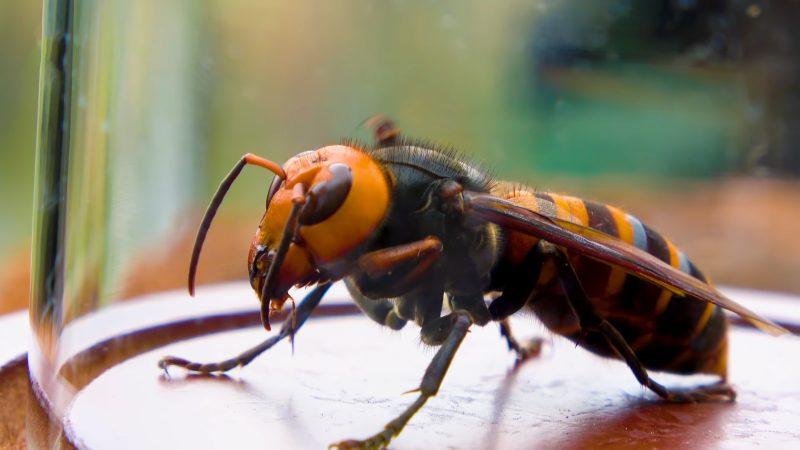
The Japanese Hornet (Vespa simillima) is an occasional invader in Michigan and often mistaken for the infamous “murder hornet” (Vespa mandarinia). It is a large, intimidating wasp species reaching about 1.2 inches in length, with a golden-orange head, dark brown thorax, and yellow-striped abdomen. Its size and loud buzzing flight make it easily recognizable, often alarming those who encounter it. Though not native to Michigan, sporadic sightings occur, typically from transported wood products or shipping materials.
Japanese Hornets are highly social insects that form large colonies. They construct paper-like nests in hollow trees, attics, or wall cavities. Their behavior is generally non-aggressive when foraging, but they will defend their nests with extreme aggression if disturbed. The hornet’s mandibles are powerful enough to decapitate other insects, including bees, which they hunt to feed their larvae.
Their sting is extremely painful and venomous, containing both neurotoxins and enzymes that cause severe burning, redness, and swelling. Multiple stings can result in systemic symptoms such as fever, dizziness, or difficulty breathing. In rare cases, allergic individuals may experience life-threatening anaphylactic reactions. Unlike bees, hornets can sting repeatedly, injecting venom with each strike.
In Michigan, Japanese Hornets are not considered an established species but may occasionally appear in southern or port areas. While they pose little long-term ecological threat, their potential danger to humans is significant due to their aggressive defense of nests. If a nest is discovered, professional pest removal is recommended rather than attempting to handle it personally.
Horsefly
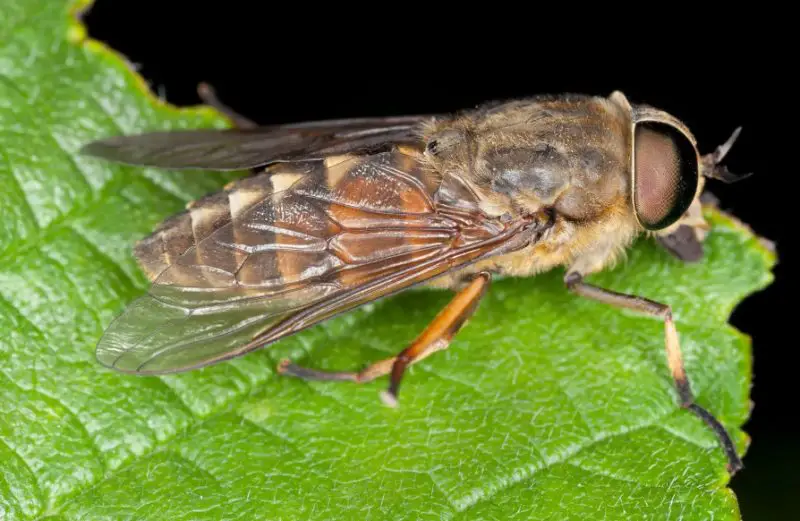
The Horsefly (Tabanus atratus and other species) is one of Michigan’s most persistent biting insects, known for its large size and painful bite. Female horseflies measure about 0.75 to 1 inch in length, with broad, dark bodies and green or purple iridescent eyes. Males are smaller and do not bite, feeding instead on nectar. Their wings are clear or slightly smoky, and their strong, buzzing flight is often heard before they are seen.
Female Horseflies require blood to produce eggs and use their sharp, scissor-like mouthparts to cut through skin and feed. Unlike mosquitoes that pierce and suck, Horseflies slice the skin open, causing immediate pain, bleeding, and swelling. Their bites can become infected if scratched and may cause allergic reactions in sensitive individuals. While they are not known to transmit diseases to humans in Michigan, they can spread pathogens among livestock.
Horseflies thrive near bodies of water such as ponds, marshes, and lakes—ideal environments for their larvae, which develop in wet soil or mud. They are especially active on hot, sunny days from late June through August. In Michigan, Horseflies are widespread, particularly in northern forested regions and along the Great Lakes where humidity and open pastures provide perfect breeding grounds.
These insects are strong fliers capable of chasing their targets for long distances. Their persistence makes outdoor work or recreation near water challenging during peak season. Wearing light-colored clothing, using repellents containing DEET, and avoiding dark colors that attract them can help minimize bites. Though painful, Horsefly bites rarely cause serious medical problems unless secondarily infected.
Deer Fly
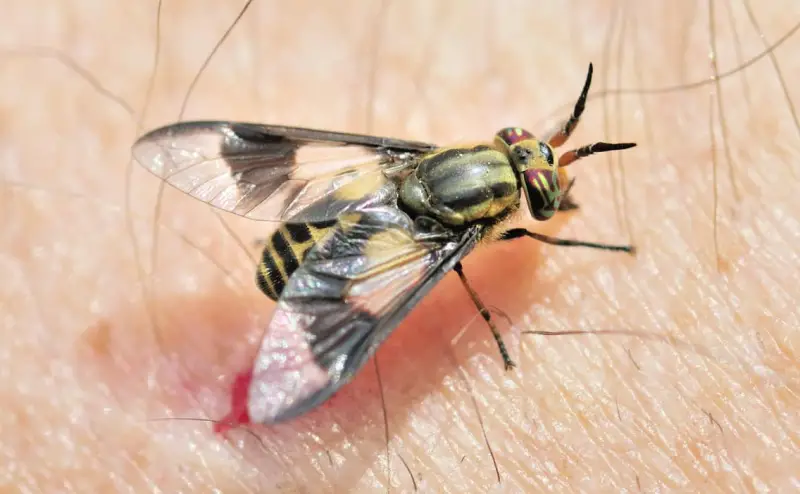
The Deer Fly (Chrysops callidus and related species) is a smaller but equally troublesome relative of the Horsefly, measuring around 0.25 to 0.5 inches long. It has patterned wings, bright green or golden eyes, and a dark brown or yellow body. Its distinctive “V” or spotted wing markings help distinguish it from other biting flies. Like Horseflies, only females bite, while males feed on nectar and pollen.
Deer Flies are most active in Michigan during midsummer, particularly from June through August. They prefer sunny, humid areas near forests, wetlands, and lakes, where their larvae develop in moist soil. These flies are notorious for circling around people’s heads and persistently attempting to bite exposed skin, often around the neck and shoulders. Their flight pattern is quick and erratic, making them difficult to swat or avoid.
The Deer Fly’s bite is sharp and painful, caused by slicing mouthparts that create a small wound to draw blood. The bite site often becomes swollen, red, and itchy, with discomfort lasting for several days. In some cases, the bites can become secondarily infected due to scratching. While Deer Flies can transmit diseases like tularemia and anthrax in other regions, such transmission is extremely rare in Michigan.
These flies are abundant in Michigan’s northern woodlands, wetlands, and along riverbanks, where deer and humans provide easy blood sources. They are attracted to motion, dark colors, and carbon dioxide. Using head nets, wearing light clothing, and avoiding outdoor activity during their peak hours in midafternoon can significantly reduce encounters.
Centipede (House Centipede)
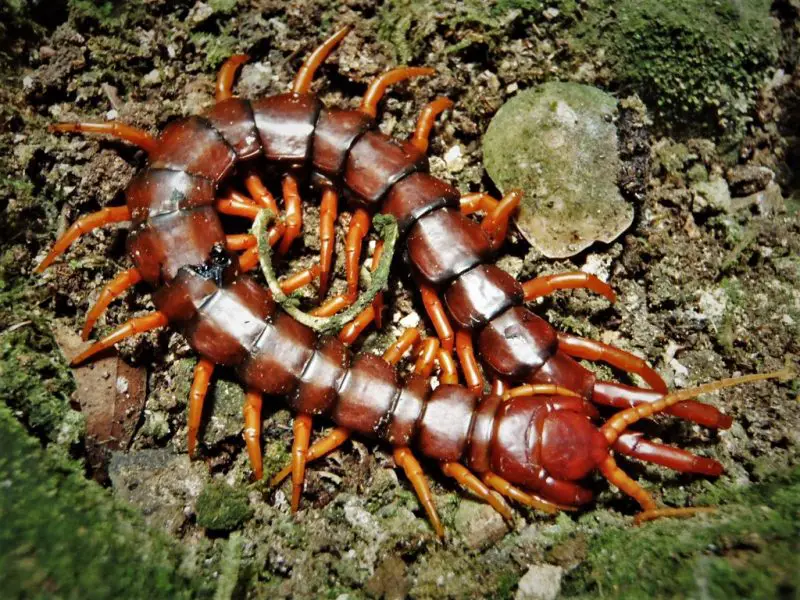
The House Centipede (Scutigera coleoptrata) is a common household arthropod found across Michigan. With its long, flattened yellowish-gray body and up to 15 pairs of slender, banded legs, it can appear alarming at first sight. Adult centipedes measure between 1 and 1.5 inches in length, but their extended legs make them look much larger. Their long antennae and swift movements often startle homeowners when they dart across floors or walls.
House Centipedes are nocturnal predators that feed on spiders, silverfish, termites, and other small insects, making them surprisingly beneficial in controlling indoor pests. They prefer damp environments such as basements, bathrooms, and crawl spaces where moisture levels are high. Though they move quickly, they are generally shy and retreat from human contact.
While House Centipedes possess venom used to subdue their prey, it is harmless to humans in most cases. They rarely bite, and when they do, their small fangs can barely penetrate the skin. A bite may cause mild pain, redness, or localized swelling, comparable to a bee sting. Only in rare allergic cases do symptoms last longer than a few hours.
In Michigan, House Centipedes are active year-round indoors and can occasionally be found outdoors under logs, rocks, or leaf litter. Controlling humidity, sealing cracks, and reducing clutter help prevent infestations. Despite their unsettling appearance, they are non-aggressive and can be considered an ally in natural pest control.
Stink Bug
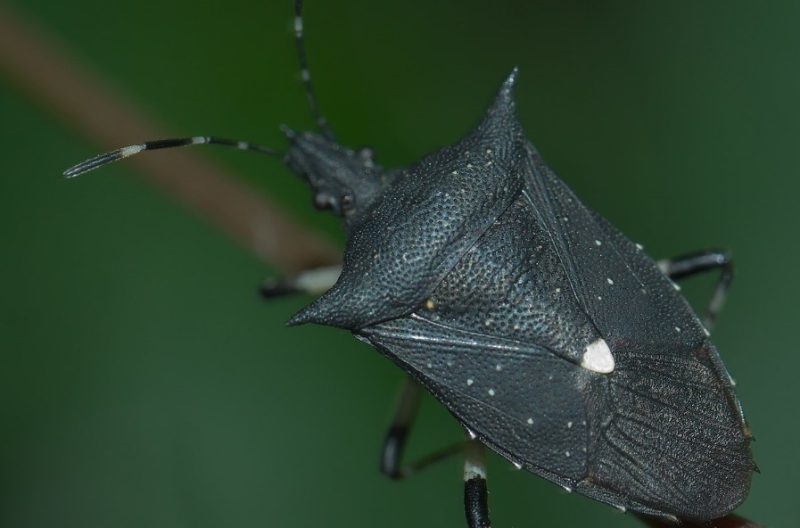
The Brown Marmorated Stink Bug (Halyomorpha halys) is a recent invasive species in Michigan that, while not dangerous through bites or stings, poses risks due to its unpleasant odor and potential to cause allergic reactions. These shield-shaped bugs are about 0.5 to 0.7 inches long with mottled brown and gray bodies and distinctive white banding on their antennae and legs. They emit a pungent, foul odor when threatened or crushed, hence their name.
Stink Bugs feed on a variety of plants, fruits, and crops, piercing the skin of produce with their proboscis to suck out juices. This feeding behavior causes spotting, deformities, and crop loss, making them a significant agricultural pest. They are particularly attracted to apples, peaches, corn, and soybeans, all of which are abundant in Michigan’s farming regions.
During late summer and early fall, Stink Bugs seek shelter in homes and buildings to overwinter. They are not venomous, but some people experience mild skin irritation, respiratory discomfort, or allergic symptoms from their secretions. The smell they release can linger for days and is difficult to remove from fabrics or furniture.
Stink Bugs are most common in southern and central Michigan, particularly around agricultural zones. They are drawn to lights at night and enter homes through cracks and window frames. To manage infestations, sealing entry points and using gentle vacuum removal (without crushing them) is effective. Though harmless, their odor and persistence make them one of the most disliked insects in the state.
Velvet Ant (Cow Killer Ant)
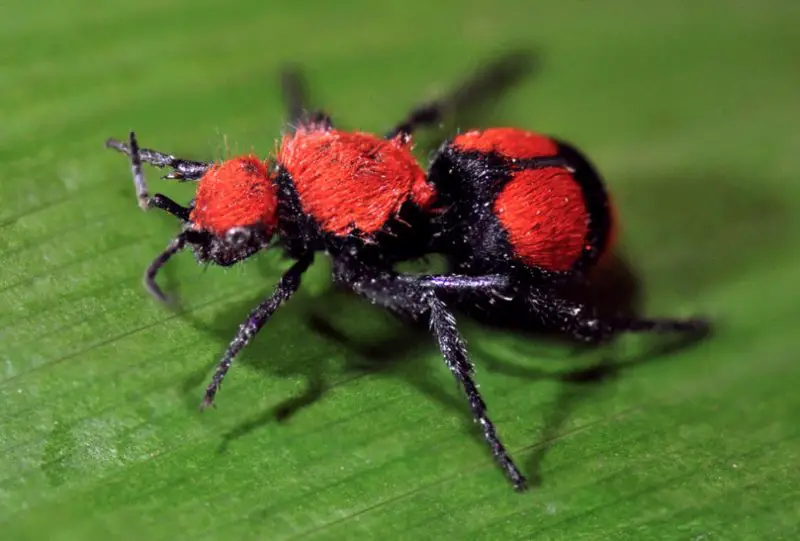
Despite its name, the Velvet Ant (Dasymutilla occidentalis) is actually a type of wingless wasp rather than a true ant. It is one of the most striking and infamous insects in Michigan, easily recognized by its bright red-orange, velvety body contrasted with black stripes. Females are wingless and measure about 0.75 inches long, while males have wings but lack the female’s powerful sting. Their vivid coloration serves as a warning to predators — a defense known as aposematism.
Velvet Ants are solitary wasps that lay their eggs in the nests of ground-nesting bees and wasps. The developing larvae feed on the host’s pupae, eventually killing them. Adults are most active in mid to late summer and can often be seen crawling quickly on sandy soils, meadows, and open fields. They are usually not aggressive but will sting if handled or trapped against the skin.
The sting of the Velvet Ant is excruciatingly painful, earning it the nickname “cow killer” because of the myth that it could kill a cow. While not lethal, the venom causes intense burning and swelling that can last for hours. The sting is considered one of the most painful among North American insects according to the Schmidt Sting Pain Index.
In Michigan, Velvet Ants are occasionally found in the southern parts of the state, particularly in sandy regions and prairies. They are solitary, fast-moving, and difficult to capture. Because of their bright coloration and defensive sting, they should be admired from a distance. Their ecological role includes controlling populations of ground-nesting bees and wasps, helping balance local ecosystems.
Wheel Bug
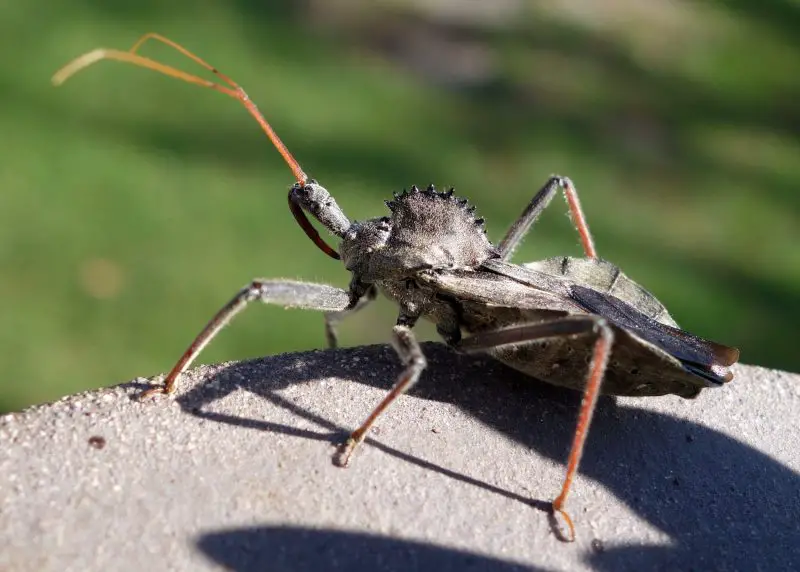
The Wheel Bug (Arilus cristatus) is one of Michigan’s largest and most intimidating assassin bugs, belonging to the same family as the Kissing Bug. It is named for the cog-like “wheel” or crest on its thorax, which gives it a prehistoric appearance. Adults can reach up to 1.5 inches in length and are grayish-brown with long legs, a narrow head, and a curved, dagger-like beak used to pierce prey.
Wheel Bugs are ambush predators that feed on caterpillars, beetles, and other soft-bodied insects, making them beneficial in gardens and agricultural fields. They move slowly but strike quickly, injecting digestive saliva that paralyzes and liquefies their prey. They then suck out the internal contents, leaving behind an empty shell. Their predatory habits help control pests naturally, though their bite can be painful to humans.
A Wheel Bug bite is not venomous but intensely painful, often described as more severe than a wasp sting. It causes immediate burning, swelling, and numbness that can persist for several days. Secondary infections may occur if the wound is not cleaned properly. However, they are not aggressive and will only bite when handled or threatened.
Wheel Bugs are found throughout Michigan, especially in wooded areas, gardens, and near fields where their prey is abundant. They are most active from late summer to early fall. While they look menacing, they are valuable allies to gardeners. Observing them from a distance ensures safety while allowing these fascinating insects to perform their natural pest control duties.
Fire Ant
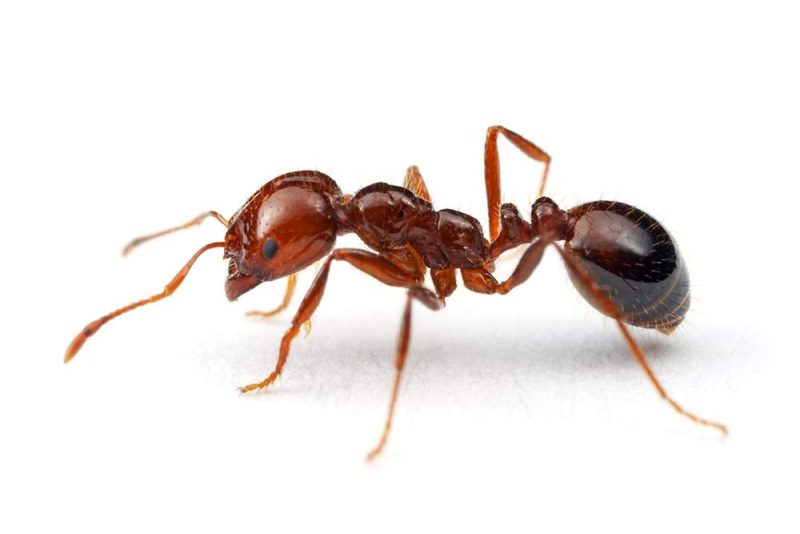
The Red Imported Fire Ant (Solenopsis invicta) is not native to Michigan, but isolated colonies have been detected through transportation of soil or plants. These reddish-brown ants are small—typically 2 to 6 mm in length—but they make up for their size with their highly aggressive behavior and potent venom. They form large colonies with hundreds of thousands of workers, often building dome-shaped mounds in sunny, open areas.
Fire Ants are known for their painful stings delivered through both biting and injecting venom. When disturbed, they swarm rapidly, climbing and stinging repeatedly. Their venom contains alkaloid toxins that cause intense burning, itching, and pustule formation at the sting site. In allergic individuals, multiple stings can lead to anaphylaxis or other severe reactions requiring medical attention.
Although Michigan’s cold winters limit their survival, Fire Ants can occasionally establish temporary nests in heated areas such as greenhouses or transported soil. They are most active in summer and thrive in disturbed areas like lawns, roadsides, and construction sites. Their presence is a concern due to their aggressive defense of nests and threat to both humans and pets.
Encounters in Michigan remain rare, but vigilance is recommended when handling imported soil or nursery plants from southern states. If suspected colonies are found, professional pest control should be contacted immediately, as Fire Ant infestations can spread rapidly under favorable conditions.
Black Fly
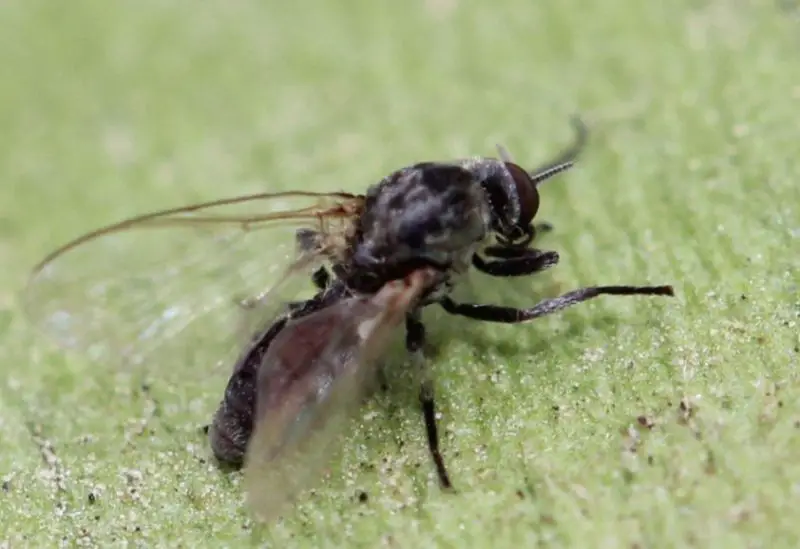
The Black Fly (Simulium venustum and related species) is a small, dark insect that poses a major nuisance in Michigan during the late spring and early summer months. Despite their tiny size—only about 1/8 inch long—these insects are aggressive biters, swarming in large numbers near rivers, streams, and lakes. Their humped back, broad wings, and short legs distinguish them from mosquitoes and gnats.
Female Black Flies require blood to produce eggs, while males feed on nectar. They target exposed areas such as the head, neck, and arms, often biting in large swarms. Their mouthparts cut the skin to lap up blood rather than pierce it, causing painful bites that swell and itch for days. Their saliva can also cause black fly fever, a reaction characterized by headaches, fever, and swollen lymph nodes in sensitive individuals.
Black Flies are most active during daylight, particularly in calm, humid weather. They breed in fast-moving streams and rivers, where larvae attach themselves to rocks and vegetation. In Michigan, they are especially abundant in northern regions such as the Upper Peninsula and around the Great Lakes, where clean, oxygenated water supports large populations.
Though not known to transmit serious diseases in Michigan, their sheer numbers can make outdoor activities unbearable. Protective clothing, head nets, and insect repellents are effective deterrents. Their presence is also an indicator of clean water, making them ecologically important despite their unpleasant reputation.
Wolf Spider
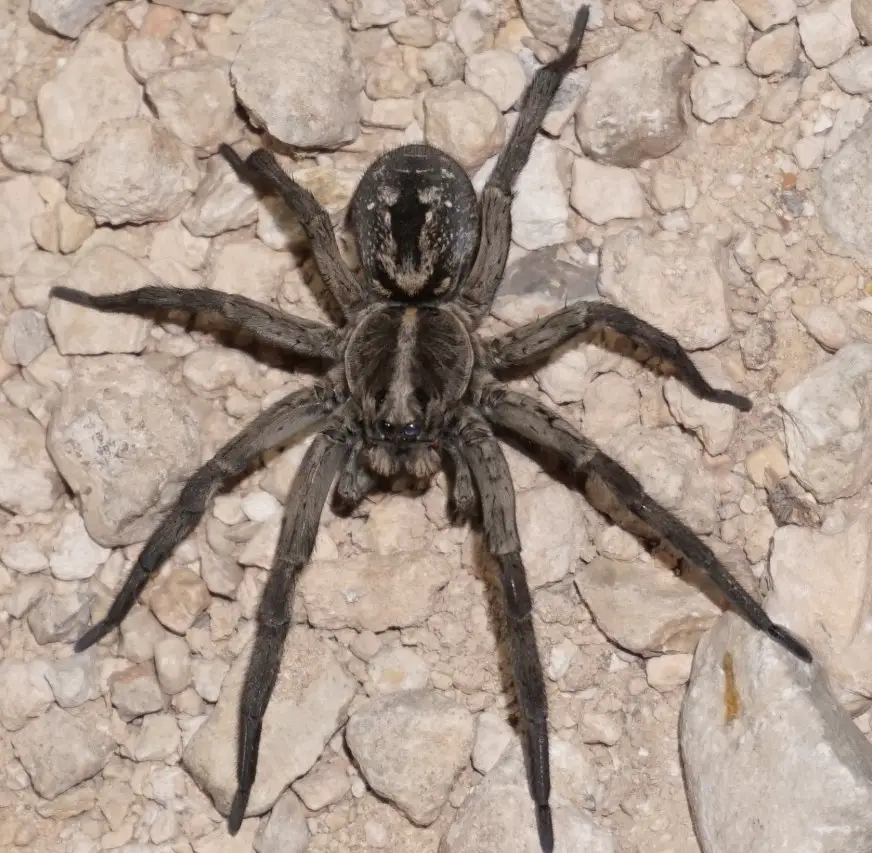
The Wolf Spider (Hogna carolinensis and related species) is one of Michigan’s largest and most recognizable spiders. Unlike web-building species, Wolf Spiders are active hunters that chase down their prey on foot. Adults can reach up to 1.5 inches in body length, with robust, hairy brown or gray bodies and long, powerful legs. Their eight reflective eyes arranged in three rows give them excellent night vision, often shining brightly in flashlight beams.
Wolf Spiders are solitary and nocturnal, spending their days hiding under rocks, logs, or leaf litter. They feed on crickets, beetles, and other ground-dwelling insects, helping control pest populations naturally. Females are unique in that they carry their egg sacs attached to their spinnerets and later transport their spiderlings on their backs after hatching—a rare behavior among spiders.
Although they may look intimidating, Wolf Spiders are not dangerous to humans. They rarely bite unless cornered or handled, and their venom is mild. A bite may cause temporary pain, redness, or mild swelling, similar to a bee sting. However, secondary infections can develop if the wound is not properly cleaned.
Wolf Spiders are found across Michigan, from forests and grasslands to suburban yards and basements. They are most active during late summer and early fall. While their speed and size can alarm people, they are beneficial predators and play an important role in maintaining ecological balance. Observing them from a distance is the best way to appreciate their fascinating behavior.
FAQs About the Most Dangerous Bugs in Michigan
What are the most dangerous bugs found in Michigan?
Michigan is home to several bugs that can pose health risks or cause painful bites and stings. The most dangerous ones include Black-Legged Ticks, which transmit Lyme disease; Mosquitoes, known for spreading West Nile Virus and Eastern Equine Encephalitis (EEE); Brown Recluse and Black Widow Spiders, whose venom can cause serious medical reactions; and stinging insects like Bald-Faced Hornets, Yellowjackets, and Paper Wasps. Other painful biters include Horseflies, Deer Flies, and Velvet Ants.
Are there venomous spiders in Michigan?
Yes, though they are rare. The two venomous spiders occasionally found in Michigan are the Brown Recluse and the Black Widow. The Brown Recluse has a distinctive violin-shaped marking on its back and can cause necrotic skin wounds. The Black Widow, identifiable by its shiny black body and red hourglass marking, delivers neurotoxic venom that causes muscle cramps, pain, and nausea. However, both species are uncommon, and bites are rarely fatal with prompt medical treatment.
Can mosquitoes in Michigan spread serious diseases?
Yes. Mosquitoes in Michigan can transmit West Nile Virus (WNV) and Eastern Equine Encephalitis (EEE). Both viruses affect the nervous system and can cause fever, headache, confusion, and, in severe cases, brain inflammation (encephalitis). EEE has one of the highest fatality rates among mosquito-borne illnesses in North America. Preventing mosquito bites through repellents, long clothing, and eliminating standing water around homes is the best protection.
Are ticks a real threat in Michigan?
Absolutely. The Black-Legged Tick (Deer Tick) is a major concern because it spreads Lyme disease. These ticks are common in wooded and grassy areas, particularly in northern and western Michigan. They latch onto hosts like deer, pets, and humans to feed on blood. The risk of infection increases the longer the tick remains attached—removing it promptly is essential. Common Lyme disease symptoms include a bull’s-eye rash, fever, and fatigue.
Which bugs in Michigan have the most painful stings?
The Velvet Ant, also known as the “Cow Killer,” is considered to have one of the most painful stings of any insect in North America. Other extremely painful stingers include Bald-Faced Hornets, Yellowjackets, Paper Wasps, and Cicada Killer Wasps. While these stings are not usually deadly, they can cause severe pain, swelling, and allergic reactions. People with venom allergies should carry an epinephrine auto-injector if stung-prone.
Do Fire Ants live in Michigan?
Fire Ants are not native to Michigan, and the state’s cold winters prevent large colonies from establishing. However, isolated infestations have been found in imported soil or greenhouse environments. The Red Imported Fire Ant delivers a burning sting followed by itchy pustules that may become infected. In rare cases, multiple stings can trigger severe allergic reactions. Michigan residents should report any suspected colonies to pest control or agricultural authorities.
Are there biting flies in Michigan that can harm humans?
Yes, several biting fly species in Michigan can cause painful bites. Horseflies and Deer Flies both use sharp mouthparts to slice skin and feed on blood, resulting in immediate pain, swelling, and itching. They are especially active in summer near lakes, rivers, and wetlands. Though their bites are rarely dangerous, they can cause secondary infections or allergic reactions if scratched excessively.
What should I do if I get bitten or stung by an insect in Michigan?
For most bites and stings, wash the area with soap and water, apply ice to reduce swelling, and use antihistamines or topical creams for itching. Avoid scratching the affected site to prevent infection. Seek immediate medical attention if you experience symptoms like dizziness, swelling of the face or throat, difficulty breathing, or a spreading rash — these may indicate a severe allergic reaction or systemic infection.
Are there any insects in Michigan that invade homes during winter?
Yes. Some bugs, such as Stink Bugs, Boxelder Bugs, and Asian Lady Beetles, enter homes during the fall to overwinter in warm, sheltered spaces. Though not dangerous, they can release unpleasant odors or trigger mild allergic reactions in sensitive individuals. Preventive measures include sealing cracks, using screens, and vacuuming them gently rather than crushing, as this can release their defensive scent.
How can I protect myself from dangerous bugs in Michigan?
Protection begins with awareness and prevention. When hiking or camping, wear long sleeves and tuck pants into socks to deter ticks and biting insects. Apply insect repellent containing DEET or picaridin, especially during mosquito and tick seasons. Keep food sealed outdoors to avoid attracting wasps and hornets. Additionally, eliminate standing water, maintain screens on windows, and check pets regularly for ticks.
When are dangerous bugs most active in Michigan?
Most dangerous insects in Michigan are active during late spring through early fall, typically from May to October. Ticks are most active in spring and fall, mosquitoes peak in midsummer, and stinging insects like hornets and wasps become more aggressive in late summer as their colonies mature. During these months, taking extra precautions when outdoors is essential to avoid bites and stings.


